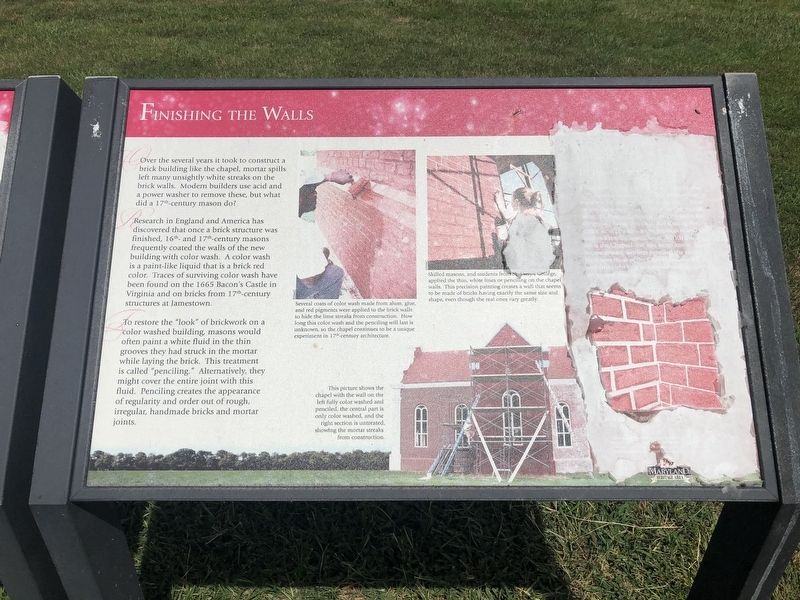St. Mary's City in St. Mary's County, Maryland — The American Northeast (Mid-Atlantic)
Finishing the Walls
Research in England and America has discovered that once a brick structure was finished, 16th- and 17th-century masons frequently coated the walls of the new building with a color wash. A color wash is a paint-like liquid that is a brick red color. Traces of surviving color wash have been found on the 1665 Bacon's Castle in Virginia and on the bricks from 17th-century structures at Jamestown.
To restore the "look" of brickwork on a color washed building, masons would often paint a white fluid in the thin grooves they had struck in the mortar while laying the brick. This treatment is called "penciling." Alternatively, they might cover the entire joint with this fluid. Penciling creates the appearance of regularity and order out of rough, irregular, handmade bricks and mortar joints.
[Captions:]
Several coats of color wash made from alum, glue, and red pigments were applied to the brick walls to hide the lime streaks from construction. How long this color wash and the penciling will last is unknown, so the chapel continues to be a unique experiment in 17th-century architecture.
Skilled masons, and students from St. Mary's College, applied the thin, white lines or penciling on the chapel walls. This precision painting creates a wall that seems to be made of bricks having exactly the same size and shape, even though the real ones vary greatly.
This picture shows the chapel with the wall on the left fully color washed and penciled, the central part is only color washed, and the right section is untreated, showing the mortar streaks from construction.
Erected by Historic St. Mary's City.
Topics. This historical marker is listed in these topic lists: Anthropology & Archaeology • Architecture • Churches & Religion. A significant historical year for this entry is 1665.
Location. 38° 10.979′ N, 76° 25.678′ W. Marker has been reported unreadable. Marker is in St. Mary's City, Maryland, in St. Mary's County. Marker can be reached from Point Lookout Road (Maryland Route 5) 0.4 miles west of Rosecroft Road, on the left when traveling west. Touch for map. Marker is at or near this postal address: 16721 Point Lookout Road, Saint Marys City MD 20686, United States of America. Touch for directions.
Other nearby markers. At least 8 other markers are within walking distance of this location. Rebuilding a Lost Chapel (here, next to this marker); An Experiment with Liberty of Conscience (within shouting distance of this marker); The Brick Chapel's History
More about this marker. The marker has significant weather damage.
Credits. This page was last revised on June 8, 2022. It was originally submitted on September 2, 2019, by Devry Becker Jones of Washington, District of Columbia. This page has been viewed 180 times since then and 14 times this year. Photos: 1, 2. submitted on September 2, 2019, by Devry Becker Jones of Washington, District of Columbia.

